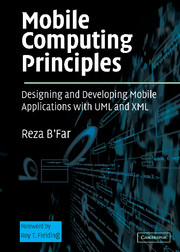Book contents
- Frontmatter
- Contents
- Foreword by Roy T. Fielding
- Acknowledgments
- SECTION 1 INTRODUCTIONS TO THE MAIN TOPICS
- SECTION 2 DEVICE-INDEPENDENT AND MULTICHANNEL USER INTERFACE DEVELOPMENT USING UML
- SECTION 3 ADDITIONAL DIMENSIONS OF MOBILE APPLICATION DEVELOPMENT
- Chapter 9 Mobile Agents and Peer-to-Peer Architectures for Mobile Applications
- Chapter 10 Wireless Connectivity and Mobile Applications
- Chapter 11 Synchronization and Replication of Mobile Data
- Chapter 12 Mobility and Location-Based Services
- Chapter 13 Active Transactions
- Chapter 14 Mobile Security
- SECTION 4 PUTTING THE PROJECT TOGETHER
- References
- Index
Chapter 12 - Mobility and Location-Based Services
from SECTION 3 - ADDITIONAL DIMENSIONS OF MOBILE APPLICATION DEVELOPMENT
Published online by Cambridge University Press: 03 September 2009
- Frontmatter
- Contents
- Foreword by Roy T. Fielding
- Acknowledgments
- SECTION 1 INTRODUCTIONS TO THE MAIN TOPICS
- SECTION 2 DEVICE-INDEPENDENT AND MULTICHANNEL USER INTERFACE DEVELOPMENT USING UML
- SECTION 3 ADDITIONAL DIMENSIONS OF MOBILE APPLICATION DEVELOPMENT
- Chapter 9 Mobile Agents and Peer-to-Peer Architectures for Mobile Applications
- Chapter 10 Wireless Connectivity and Mobile Applications
- Chapter 11 Synchronization and Replication of Mobile Data
- Chapter 12 Mobility and Location-Based Services
- Chapter 13 Active Transactions
- Chapter 14 Mobile Security
- SECTION 4 PUTTING THE PROJECT TOGETHER
- References
- Index
Summary
If the rich could hire someone else to die for them, the poor would make a wonderful living.
Jewish proverbINTRODUCTION
Location, location, location. The changing location of the user and the device used by the user make mobile applications fundamentally different from their stationary counterparts. Yet, most software developers, even those who have some experience with mobile applications, have little experience and understanding in how location-based information is gathered and distributed and how this information may be utilized by mobile applications. Although we will not be able to cover all aspects of location-based information in mobile applications, we will try to tackle the basic problems in this chapter.
If you have looked into developing mobile applications, you have certainly heard of “location-based services.” The UTMS Forum defines location-based services as follows:
Business and consumer 3G services that enable users or machines to find other people, vehicles, resources, services, or machines. They also enable others to find users as well as enabling users to identify their own location via terminal or vehicle identification.
This definition is somewhat narrow as it limits location-based services to 3G services. There are many location-based services that do not have any relationship with 3G services. So, location-based services are those things that provide the mobile device, the mobile application, and the mobile user with location information about themselves or other devices, applications, and users.
- Type
- Chapter
- Information
- Mobile Computing PrinciplesDesigning and Developing Mobile Applications with UML and XML, pp. 676 - 722Publisher: Cambridge University PressPrint publication year: 2004



